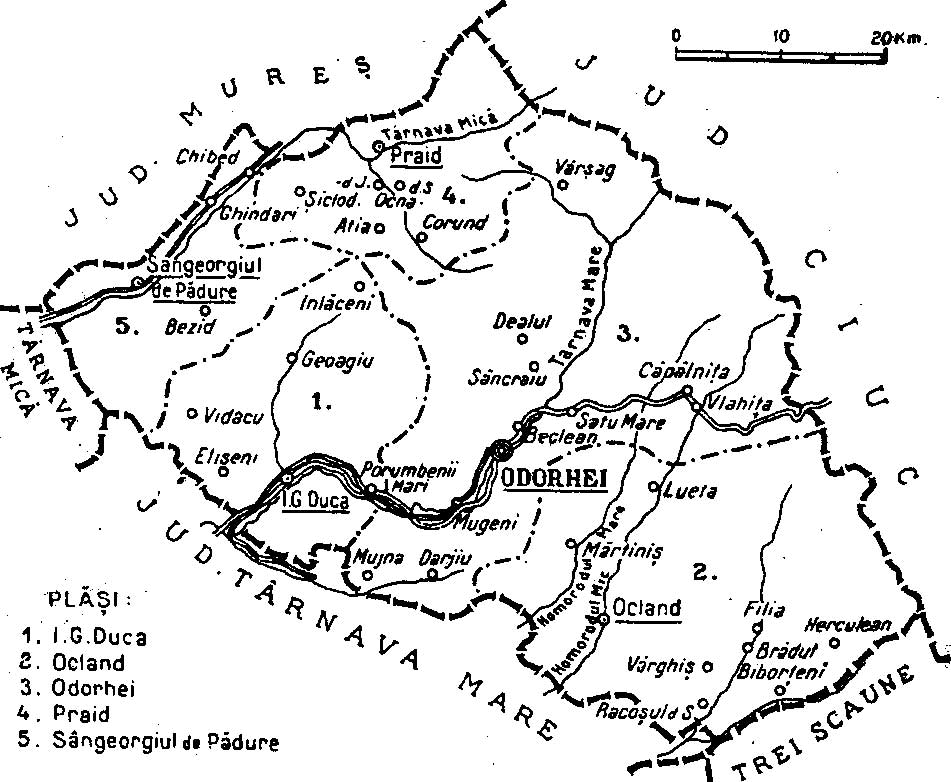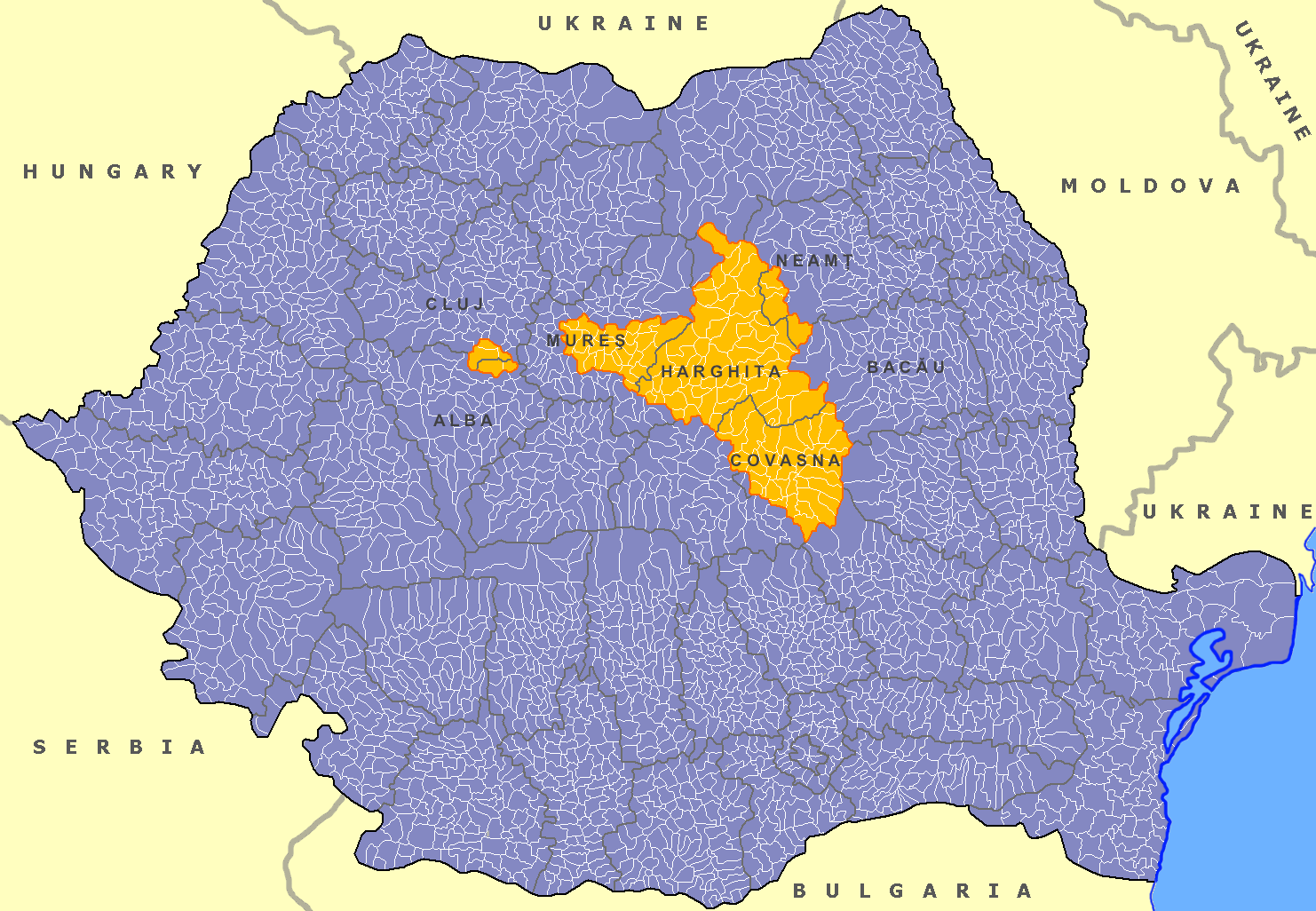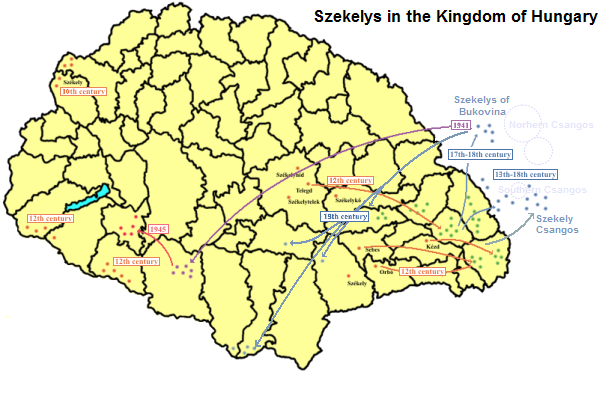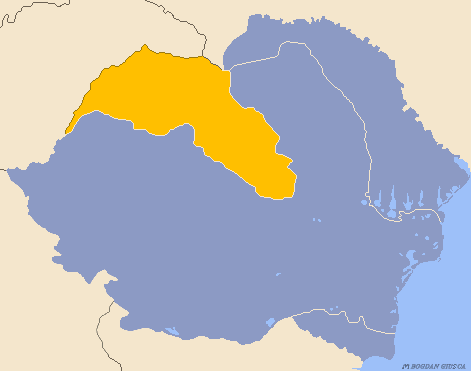|
Odorhei
Odorheiu Secuiesc (; hu, Székelyudvarhely, ; german: Odorhellen) is the second largest municipality in Harghita County, Transylvania, Romania. In its short form, it is also known as ''Odorhei'' in Romanian and ''Udvarhely'' in Hungarian. The Hungarian name of the town "Udvarhely" means "courtyard place". Demographics The city has a population of 34,257. Among those for whom data are available, 95.8% are ethnic Hungarians, making it the urban settlement with the third-highest proportion of Hungarians in Romania. The city is also home to communities of ethnic Romanians (2.6%) and Roma (1.5%). Half the population of the town professes Roman Catholicism (50.05%), while the remaining half is primarily divided between Hungarian Reformed (30.14%), Unitarian (14.71%), and Romanian Orthodox (2.54%) communities. History A Roman fortress was found under the ruins of a medieval fort in the centre of the town. A funeral inscription was also found placed by the veteran, Aelius Equester, ... [...More Info...] [...Related Items...] OR: [Wikipedia] [Google] [Baidu] |
Odorhei County
Odorhei County was a county (Romanian: '' județ'') in the Kingdom of Romania. The county seat was Odorheiu Secuiesc. Geography Odorhei County covered 2,977 km2 and was located in central part of Greater Romania, in eastern part of the historical region of Transylvania. It was bordered by Târnava-Mică County and Târnava-Mare County to the west and southwest, Mureș County to the north, Ciuc County to the east, and Brașov County and Trei-Scaune County to the south. Odorhei county was abolished in the administrative reforms of September 6, 1950. Currently, the territory that comprised the greater part of Odorhei County is now part of Harghita County, with some territory now belonging to the present-day counties of Covasna and Mureș. History Prior to World War I, the territory of the county belonged to Austria-Hungary and was identical with the Udvarhely County of the Kingdom of Hungary. The territory of Odorhei County was transferred to Romania from Hungary as successor sta ... [...More Info...] [...Related Items...] OR: [Wikipedia] [Google] [Baidu] |
Székely Land
The Székely Land or Szeklerland ( hu, Székelyföld, ; ro, Ținutul Secuiesc and sometimes ; german: Szeklerland; la, Terra Siculorum) is a historic and ethnographic area in Romania, inhabited mainly by Székelys, a subgroup of Hungarians. Its cultural centre is the city of Târgu Mureș (Marosvásárhely), the largest settlement in the region. Székelys (or Szeklers) live in the valleys and hills of the Eastern Carpathian Mountains, corresponding mostly to the present-day Harghita, Covasna, and parts of Mureș counties in Romania. Originally, the name ''Székely Land'' denoted the territories of a number of autonomous Székely seats within Transylvania. The self-governing Székely seats had their own administrative system, and existed as legal entities from medieval times until the 1870s. The privileges of the Székely and Saxon seats were abolished and seats were replaced with counties in 1876. Along with Transylvania and eastern parts of Hungary proper, the Széke ... [...More Info...] [...Related Items...] OR: [Wikipedia] [Google] [Baidu] |
Udvarhely County
Udvarhely (german: Oderhellen) was an administrative county (comitatus) of the Kingdom of Hungary. Its territory is now in central Romania (eastern Transylvania). The capital of the county was ''Székelyudvarhely'' (now Odorheiu Secuiesc). Geography Udvarhely county shared borders with the counties of Maros-Torda, Csík, Háromszék, Nagy-Küküllő, and Kis-Küküllő. The county lay in the Carpathian Mountains. Its area was 2,938 km2 around 1910. History Udvarhely county consisted of three former seats of the Székelys: Udvarhelyszék, Bardóc and Keresztúr (the latter two as filial seats of the former). It was formed in 1876, when the administrative structure of Transylvania was changed. In 1920, by the Treaty of Trianon, the county became part of Romania until 1940 when, by the Second Vienna Award, much of its territory was reassigned to Hungary. After the end of World War II it became again part of Romania. Most of its territory lies in the present-day Romanian ... [...More Info...] [...Related Items...] OR: [Wikipedia] [Google] [Baidu] |
Harghita County
Harghita (, hu, Hargita megye, ) is a county (județ) in the center of Romania, in eastern Transylvania, with the county seat at Miercurea Ciuc. Demographics 2002 census In 2002, Harghita County had a population of 326,222 and a population density of 52/km2. * Hungarians – 84.62% (or 276,038) * Romanians – 14.06% (or 45,870) * Romani – 1.18% (or 3,835) * Others – 0.14% 2011 census In 2011, it had a population of 302,432 and a population density of 46/km2. * Hungarians – 85.21% (or 257,707) * Romanians – 12.96% (or 39,196) * Romani * Others – 1.76% (or 5,326). Harghita county has the highest percentage of Hungarians in Romania, just ahead of Covasna county. The Hungarians form the majority of the population in most of the county's municipalities, with Romanians concentrated in the northern and eastern part of the county (particularly Toplița and Bălan), as well as in the enclave of Voșlăbeni. The Székelys of Harghita are mostly Roman Catholic, ... [...More Info...] [...Related Items...] OR: [Wikipedia] [Google] [Baidu] |
Székelys
The Székelys (, Székely runes: 𐳥𐳋𐳓𐳉𐳗), also referred to as Szeklers,; ro, secui; german: Szekler; la, Siculi; sr, Секељи, Sekelji; sk, Sikuli are a Hungarian subgroup living mostly in the Székely Land in Romania. A significant population descending from the Székelys of Bukovina lives in Tolna and Baranya counties in Hungary and certain districts of Vojvodina, Serbia. In the Middle Ages, the Székelys played a role in the defense of the Kingdom of Hungary against the Ottomans in their posture as guards of the eastern border. With the Treaty of Trianon of 1920, Transylvania (including the Székely Land) became part of Romania, and the Székely population was a target of Romanianization efforts. In 1952, during the communist rule of Romania, the former counties with the highest concentration of Székely population – Mureș, Odorhei, Ciuc, and Trei Scaune – were legally designated as the Magyar Autonomous Region. It was superseded in 1960 ... [...More Info...] [...Related Items...] OR: [Wikipedia] [Google] [Baidu] |
Northern Transylvania
Northern Transylvania ( ro, Transilvania de Nord, hu, Észak-Erdély) was the region of the Kingdom of Romania that during World War II, as a consequence of the August 1940 territorial agreement known as the Second Vienna Award, became part of the Kingdom of Hungary. With an area of , the population was largely composed of both ethnic Romanians and Hungarians. In October 1944, Soviet and Romanian forces gained control of the territory, and by March 1945 Northern Transylvania returned to Romanian administration. After the war, this was confirmed by the Paris Peace Treaties of 1947. Background The region has a varied history. It was once the nucleus of the Kingdom of Dacia (82 BC–106 AD). In 106 AD the Roman Empire conquered the territory, systematically exploiting its resources. After the Roman legions withdrew in 271 AD, it was overrun by a succession of various tribes, bringing it under the control of the Carpi, Visigoths, Huns, Gepids, Avars, and Slavs. During the 9th ... [...More Info...] [...Related Items...] OR: [Wikipedia] [Google] [Baidu] |
Unitarian Church Of Transylvania
The Unitarian Church of Transylvania ( hu, Erdélyi Unitárius Egyház; ro, Biserica Unitariană din Transilvania), also known as the Hungarian Unitarian Church ( hu, Magyar Unitárius Egyház; ro, Biserica Unitariană Maghiară), is a Christian church of the Unitarian tradition, based in the city of Cluj, Transylvania, Romania. Founded in 1568 in the Eastern Hungarian Kingdom, it is the oldest continuing Unitarian denomination in the world. It has a majority- Hungarian following, and is one of the 18 religious denominations given official recognition by the Romanian state. The Transylvanian and Hungarian Unitarians represent the only branch of Unitarianism not to have adopted a congregationalist polity, and remains quasi- episcopal; the Irish Non-subscribing Presbyterian Church, a distinct body closely related to Unitarianism, has a presbyterian structure.Paul F. Bradshaw, ''The New SCM Dictionary of Liturgy and Worship'', SCM-Canterbury Press Ltd, London, 2002, p.460. ... [...More Info...] [...Related Items...] OR: [Wikipedia] [Google] [Baidu] |
Municipiu
A municipiu (from Latin ''municipium''; English: municipality) is a level of administrative subdivision in Romania and Moldova, roughly equivalent to city in some English-speaking countries. In Romania, this status is given to towns that are large and urbanized; at present, there are 103 ''municipii''. There is no clear benchmark regarding the status of ''municipiu'' even though it applies to localities which have a sizeable population, usually above 15,000, and extensive urban infrastructure. Localities that do not meet these loose guidelines are classified only as towns (''orașe''), or if they are not urban areas, as communes (''comune''). Cities are governed by a mayor and local council. There are no official administrative subdivisions of cities even though, unofficially, municipalities may be divided into quarters/districts (''cartiere'' in Romanian). The exception to this is Bucharest, which has a status similar to that of a county, and is officially subdivided into six adm ... [...More Info...] [...Related Items...] OR: [Wikipedia] [Google] [Baidu] |
Romanian People
The Romanians ( ro, români, ; dated exonym ''Vlachs'') are a Romance-speaking ethnic group. Sharing a common Romanian culture and ancestry, and speaking the Romanian language, they live primarily in Romania and Moldova. The 2011 Romanian census found that just under 89% of Romania's citizens identified themselves as ethnic Romanians. In one interpretation of the 1989 census results in Moldova, the majority of Moldovans were counted as ethnic Romanians.''Ethnic Groups Worldwide: A Ready Reference Handbook By'' David Levinson, Published 1998 – Greenwood Publishing Group.At the time of the 1989 census, Moldova's total population was 4,335,400. The largest nationality in the republic, ethnic Romanians, numbered 2,795,000 persons, accounting for 64.5 percent of the population. Source U.S. Library of Congress "however it is one interpretation of census data results. The subject of Moldovan vs Romanian ethnicity touches upon the sensitive topic ofMoldova's national identit ... [...More Info...] [...Related Items...] OR: [Wikipedia] [Google] [Baidu] |
Habsburg Monarchy
The Habsburg monarchy (german: Habsburgermonarchie, ), also known as the Danubian monarchy (german: Donaumonarchie, ), or Habsburg Empire (german: Habsburgerreich, ), was the collection of empires, kingdoms, duchies, counties and other polities that were ruled by the House of Habsburg, especially the dynasty's Austrian branch. The history of the Habsburg monarchy can be traced back to the election of Rudolf I as King of Germany in 1273 and his acquisition of the Duchy of Austria for the Habsburg in 1282. In 1482, Maximilian I acquired the Netherlands through marriage. Both realms passed to his grandson and successor, Charles V, who also inherited the Spanish throne and its colonial possessions, and thus came to rule the Habsburg empire at its greatest territorial extent. The abdication of Charles V in 1556 led to a division within the dynasty between his son Philip II of Spain and his brother Ferdinand I, who had served as his lieutenant and the elected king of Hungary and ... [...More Info...] [...Related Items...] OR: [Wikipedia] [Google] [Baidu] |
World War II
World War II or the Second World War, often abbreviated as WWII or WW2, was a world war that lasted from 1939 to 1945. It involved the vast majority of the world's countries—including all of the great powers—forming two opposing military alliances: the Allies and the Axis powers. World War II was a total war that directly involved more than 100 million personnel from more than 30 countries. The major participants in the war threw their entire economic, industrial, and scientific capabilities behind the war effort, blurring the distinction between civilian and military resources. Aircraft played a major role in the conflict, enabling the strategic bombing of population centres and deploying the only two nuclear weapons ever used in war. World War II was by far the deadliest conflict in human history; it resulted in 70 to 85 million fatalities, mostly among civilians. Tens of millions died due to genocides (including the Holocaust), starvation, ma ... [...More Info...] [...Related Items...] OR: [Wikipedia] [Google] [Baidu] |
Second Vienna Award
The Second Vienna Award, also known as the Vienna Diktat, was the second of two territorial disputes that were arbitrated by Nazi Germany and Fascist Italy. On 30 August 1940, they assigned the territory of Northern Transylvania, including all of Maramureș and part of Crișana, from Romania to Hungary. Background After World War I, the multiethnic Kingdom of Hungary was divided by the 1920 Treaty of Trianon to form several new nation states, but Hungary noted that the new state borders did not follow ethnic boundaries. The new nation state of Hungary was about a third the size of prewar Hungary, and millions of ethnic Hungarians were left outside the new Hungarian borders. Many historically-important areas of Hungary were assigned to other countries, and the distribution of natural resources was uneven. The various non-Hungarian populations generally saw the treaty as justice for their historically-marginalised nationalities, but the Hungarians considered the treaty to have ... [...More Info...] [...Related Items...] OR: [Wikipedia] [Google] [Baidu] |







.png)
